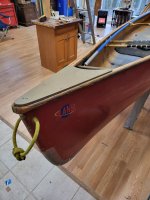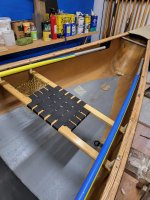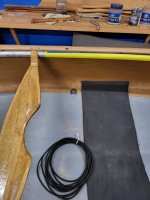The bungee cord could be used for painter keepers on the deck plates. With a large enough deck plate I like the bungee run / \; if I put the painter between the two bungees and pull it out the same way it can’t get trapped under a single bungee, accidentally stretching it out caught underneath when I hurriedly grab the painter.
 PC150024
PC150024 by
Mike McCrea, on Flickr
Run as a single continuous bungee line that also gives me under-deck bungee, which is occasionally useful.
 PC150025
PC150025 by
Mike McCrea, on Flickr
One helpful trick with bungee there, or anywhere else, if you run one end of the bungee through a cord lock, leave some slack and then tie off a stopper knot you can adjust the bungee cord tension as desired.
How about a drain hole in the deck plate? That hole at the very tip of the deck plate is a good place to feed a line from the end of a stem float bag. The wire hook cord puller is easier to poke up from underneath when feeding the line through before tying it off to a carry handle.
 PB260019
PB260019 by
Mike McCrea, on Flickr
(Shortie deck cap, no room for / \ bungee)
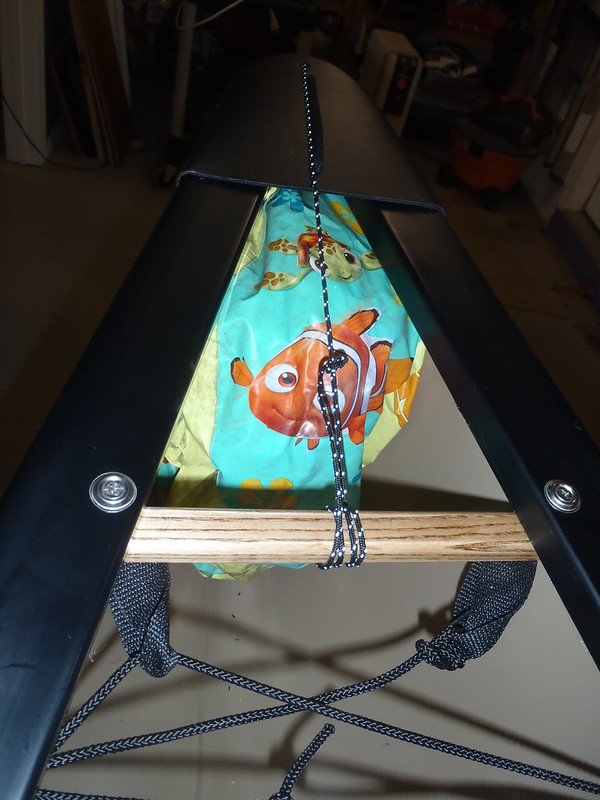 PC100027
PC100027 by
Mike McCrea, on Flickr
No, that isn’t a Finding Nemo float bag, it is a half-deflated Dollar Store mini-beach ball, AKA a house wren nest preventer, occluding that tempting cavity. That canoe is stored outside, and I don’t want wrens building nests in the deck plate stem cavities.
The rest of the bungee could be run across a thwart, or thwarts. Good place to stash map, sunglasses or gloves while underway.
 PC200032
PC200032 by
Mike McCrea, on Flickr
 PC200034
PC200034 by
Mike McCrea, on Flickr
Some kind of little spacer makes it easier to grab and lift the thwart bungees. And easier to shove a spare paddle blade under, just make the lateral bungee a bit wider than your paddle blade. If you have thwarts in the needed spacing that might be your “slide paddles back and forth for trim weight when carrying the canoe” solution.
You can use the yoke for paddle grip bungee, just make the topside bungee short and not in the yoke neck area.
 P2030022
P2030022 by
Mike McCrea, on Flickr
That is a rod holder fishing yoke, but same idea. I put the paddle grips under the short bungee runs on either side of the neck area, with the blades held under the wider thwart bungees. As usual, a cord lock on one bungee end helps adjust bungee tension.
 P2030024
P2030024 by
Mike McCrea, on Flickr
The wider bungee run is under the yoke, where it is not in the way when carrying the canoe, and still useful for securing misc items when underway.
Sturdy gunwale-height tie points are as easy as adding webbing loops to the ends of the machine screws, under the thwarts or yoke. A length of 1” wide webbing, folded over, melt/seal a 3/16” hole through the ends. I use a 20 penny common nail heated with propane torch and tape the ends together before melting the machine screw holes.
 P1060046
P1060046 by
Mike McCrea, on Flickr
These are 3/16” holes for a strap yoke, but same sealed/melted machine screw hole idea.
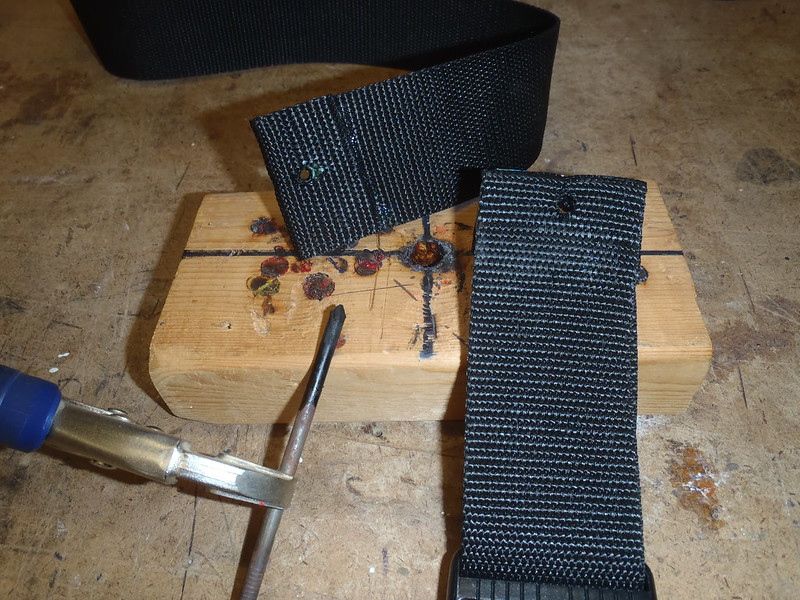 PB260010
PB260010 by
Mike McCrea, on Flickr
The webbing loops are handy as hell, and I already have the machine screw shanks, no need to drill more holes. Might as well install pairs, one facing fore, one aft.
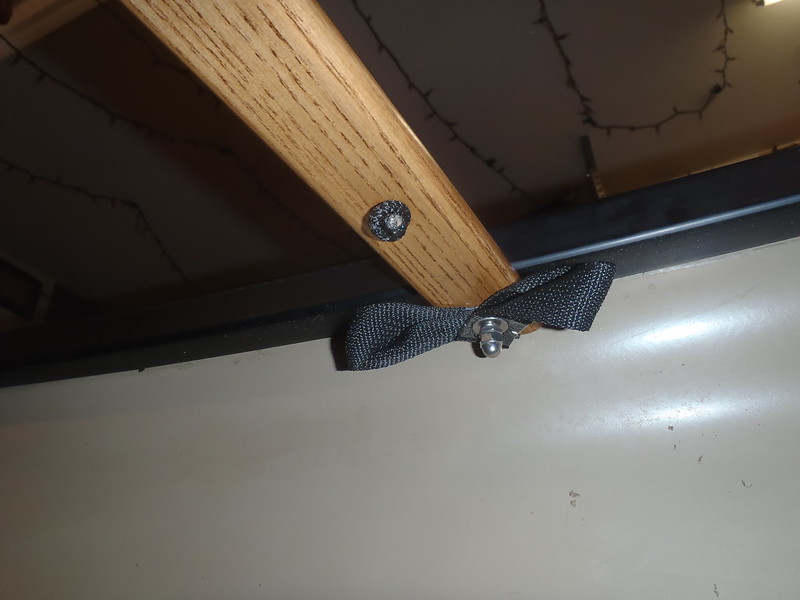 PB210016
PB210016 by
Mike McCrea, on Flickr
Maybe a DIY foot brace? This is just a couple pieces of aluminum L, drilled for foot bar adjustment, with a telescoping bar and wing nuts. Yeah, I pad my foot braces with split foam pipe insulation for barefoot or bootie comfort.
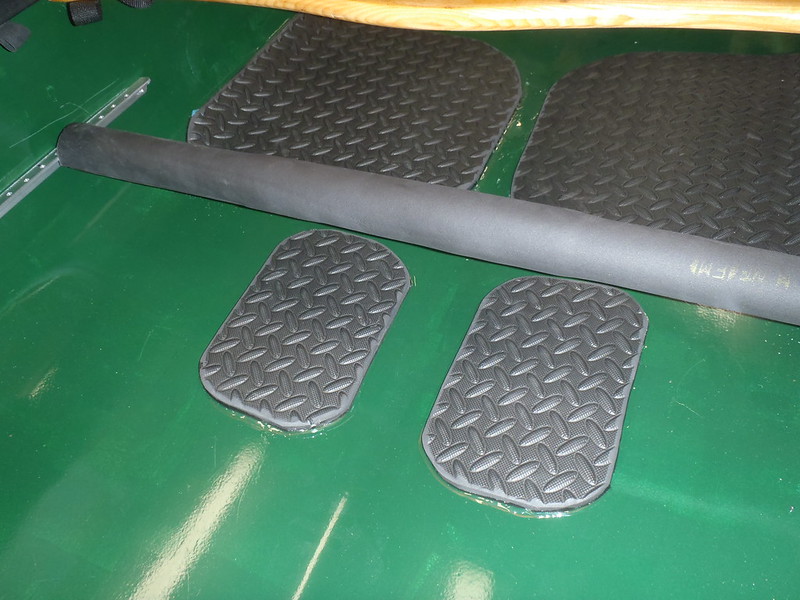 P1180018
P1180018 by
Mike McCrea, on Flickr
For sitting and using a foot brace a piece of minicel along the inwale edge adds a lot of knee brace comfort.
 P1080017
P1080017 by
Mike McCrea, on Flickr
Those are for knee braces wider leg spread when paddling bow backwards. For bow or stern tandem use the “knee bumpers” don’t need to be as wide, just some thin minicel along the inwale edge.
 P1070001
P1070001 by
Mike McCrea, on Flickr
(Conk, thanks again for the knee bumper supply)
Other than a foot brace that stuff, some bungee, a couple cord locks, some webbing and some minicel adds very little outfitting weight, and does add a lot of comfort and functionality.
